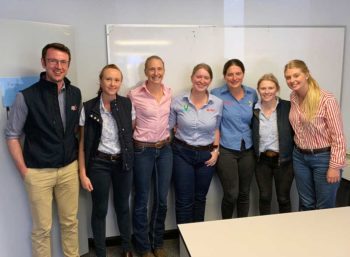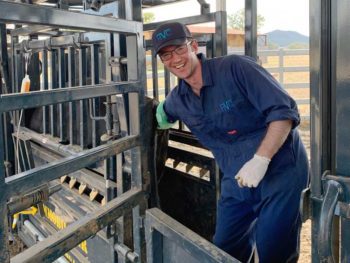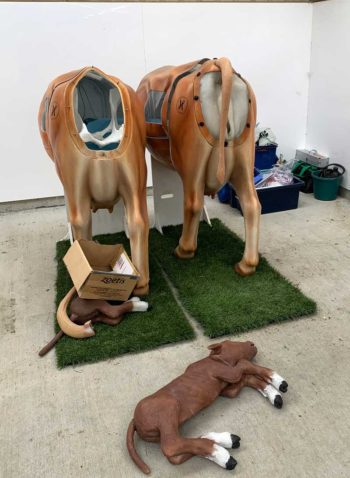3 Dec 2021
John Remnant BVSc, CertAVP, DipECBHM, PhD, SFHEA, MRCVS discusses findings from his scholarship exploring how the profession meets future needs in livestock agriculture.

Map: © FourLeafLover / Adobe Stock
Livestock agriculture is constantly evolving, with a trend towards larger farms and increased use of technology.
Alongside this, the farm veterinary profession is also changing (Woodward et al, 2019).
Access to veterinary services is essential to maintain livestock health and welfare, as well as consumer confidence in livestock production.
In 2019, I was awarded a Nuffield Farm Scholarship, sponsored by The Trehane Trust to investigate the topic internationally, under the title “Ensuring the veterinary profession meets the needs of livestock agriculture now and in the future”.
A Nuffield Farming Scholarship provides recipients with funding and support to undertake an eight-week international study tour to research a topic of importance to UK agriculture. To read more about the scheme and apply, visit www.nuffieldscholar.org
After the initial briefings and training weeks in both the UK and US, I started planning my tour. I visited veterinary schools, veterinary practices and farms in the Netherlands, Canada, US, New Zealand and Australia.
Before travelling overseas, I spent time discussing challenges the sector faces with colleagues in the UK. It became clear that while services provided by veterinary businesses to farms would inevitably need to evolve, the biggest challenge to the future of farm animal practice was recruitment and retention of vets in the farm animal sector.
Throughout my study tour I wanted to ensure I focused on the entire “farm vet pipeline” – learning about approaches used overseas to encourage and support vets, and aspiring vets, to enter and remain in the livestock sector.
Below, I describe a few highlights of my trips.
By discussing these topics internationally, I learned that many of our challenges in the UK are shared globally.
There is no silver bullet, but there are tried and tested approaches at all steps of the farm vet pipeline that we can use to address recruitment and retention issues, as well as adapting veterinary businesses to better serve modern farmers.
I would like to thank the Nuffield Farming Scholarships Trust and The Trehane Trust for their support, and extend my thanks to all those who hosted me and those who covered for me while I was away.
The full report on my study tour is available here https://bit.ly/3FM2g6W
Initially, I was based at Ontario Veterinary College in Guelph, Ontario, which is home to a large dairy research group. I spent time with academics, veterinary students, farmers and visited some local veterinary practices.
For the second part of my trip I was based in Calgary, Alberta, visiting the University of Calgary Faculty of Veterinary Medicine, and neighbouring farms and veterinary practices.
I also attended a dairy farmer discussion group in rural Alberta, to discuss what the farmers looked for in a vet.
Like the visit to the Dairy Campus in the Netherlands, the technology being used and developed in the research facilities was fascinating. The use of on‑farm and on‑cow sensors is continually developing, and as a result vets need to adapt to working alongside these technologies, helping farms use the resulting data to improve animal health, welfare and production.
This requires quite a different skill set compared to traditional clinical skills taught at veterinary schools. Although, it was well accepted that the more traditional, hands-on clinical skills are still essential for new graduate vets to have any credibility.
What was striking, particularly in Alberta, was the scale and remoteness of rural Canada. Providing veterinary cover to farms over such a wide geographic area presents a huge challenge, and raises an interesting question about who’s responsibility it is to ensure veterinary care is available to livestock.
Evidence was present of technology being used to address some of these challenges. Feedlot Health Services, based in Alberta, has feedlot clients as far away as Mexico and Kazakhstan. The practice use technology to monitor and advise farms remotely, with trained farm staff and local technicians providing many traditional veterinary skills on the farms.
While visiting Canada, I also crossed the border into the US to spend some time in Minnesota, visiting the University of Minnesota College of Veterinary Medicine and its dairy teaching facility run alongside a private commercial dairy farm.
By working with a large (10,000‑cow) dairy farm, the veterinary school was able to provide extensive experience to the veterinary students. This experience included husbandry and veterinary procedures, such as pregnancy diagnosis and calvings, but it also enabled students to get a deep understanding of the pressures of working on a farm.
I started my visit to Australia by attending the Vet Ed Down Under veterinary education conference at The University of Queensland School of Veterinary Science, just outside Brisbane, meeting farm vet educators from across Australia.
This was followed by a visit to Charles Sturt University’s Wagga Wagga Campus, home of the Charles Sturt School of Agricultural, Environmental and Veterinary Sciences – a vet school opened specifically to address the shortage of veterinary surgeons working in rural Australia.

I ended my trip in Melbourne, discussing The University of Melbourne Faculty of Veterinary and Agricultural Sciences’ postgraduate farm animal residency programme and speaking to vets working for Dairy Australia.
A theme running throughout Vet Ed Down Under was improving opportunities and access for people typically under‑represented in the veterinary profession. This was echoed in a farm‑specific context by conversations with veterinary students and educators.
A feeling existed that many people were put off a career in farm animal veterinary practice because they struggle to access appropriate work experience, or because they are not made to feel welcome in farm practices or agricultural communities.
Charles Sturt Vet School tries to reflect this in its contextual admission process – admissions decisions are based on motivation and understanding, and what you have done with the opportunities available to you given your circumstances. The school noted that meeting its mission of training enough vets for rural Australia was unlikely to be met by just recruiting people who grew up on farms.
I visited the Netherlands twice – once to spend time based at Utrecht University Faculty of Veterinary Medicine; the second to attend the European Bovine Congress, with the conference theme “Your veterinary toolbox 2025”.
I was also able to visit numerous dairy farms in Friesland, including the Dairy Campus research farm, as well as farms around Utrecht with the University Farm Animal Practice.

Utrecht vet school has more pronounced “tracking” than many other European veterinary schools. Students complete a bachelor’s degree in the first three years of the programme, then undertake a master’s in equine, small animal or production animal medicine for the final three years.
While all tracks have some cross‑species and first-aid elements, this approach allows a much more focused area of study in the discipline of interest to the students.
I had the opportunity to speak to staff about the motivation for this approach and to talk to students about their rationale for selecting the production animal track.
Interestingly, the students on the farm track who I spoke to described choosing the track to broaden their career opportunities to include policy, public health and food chain work. This seems to contrast with work in the UK identifying concerns about no “backup option” as a potential barrier to farm careers (Payne et al, 2021).
Visiting a series of farms in Friesland and discussing public perception of agriculture highlighted how a lot of value seemed to exist in communicating to the wider public goods that farmers and their vets contribute, to potential and existing vet students.

In New Zealand, I visited several large rural practices to discuss recruitment and retention, and the services they provide to their clients.
This was followed by time at Massey University speaking to veterinary students and educators, as well as a trip to the Ministry of Primary Industries to discuss government support for rural veterinary practices.
As with the other countries visited, New Zealand struggles with recruitment – and particularly retention – of vets in rural practices.
The practices visited explained their various approaches to being a place people wanted to work. Many employers were focused on promoting the practice as part of the community and then encouraging new vets to become involved in community activities. This included practice events, but also ensuring recent graduates had enough time off to participate in community events, and join local groups and sports teams.
In both Canada and New Zealand, employers talked about the importance of building links with local veterinary schools to inform veterinary student teaching, but also as a route to recruitment by demonstrating to students what a good workplace they offered. Despite these efforts, concerns about rural veterinary provision have prompted the Ministry of Primary Industries to offer a bursary to new graduates taking employment in approved rural practices.